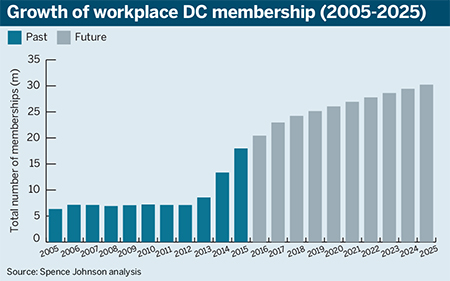Magnus Spence from research consultancy Spence Johnson gives an estimate of how big the defined contribution market is and how fast it could grow.
As I opened my mouth to answer, the horrible truth began to dawn: that I didn’t know. I must have said something that bought me time, because I spent the next two weeks trying to get an answer to that same apparently simple question.
Despite DC being the cornerstone of the nation's pensions policy for years into the future, we are all still reliant on estimates
Not so simple, it turns out. The regulators and the Office for National Statistics were (and still are) unwilling for their own reasons to exert their strong market position to provide the industry with anything but the most meagre help in this regard.
So despite this being one of the most important elements of our national balance sheet, and the cornerstone of pensions policy for years into the future, we were, and are all still, reliant on estimates and best guesses as to what it consists of.
DC market size can only be estimated
When I returned to my client, I said: “You will be amazed to know that no one has a clue what the answer is. A large consulting firm says it's £600bn. So does a large asset management company that claims to know this market. And so does a huge insurance company. But we believe it is probably half this.”
My client’s response? To describe the UK pensions market as 'third world' for its lack of data. Ouch.
Today if I am asked this question (and we are now asked it probably once a week), I am able to say that after much thought and careful estimating, my colleagues think the total value of all UK DC assets in 2015 was £303bn.
But it is still an estimate and, incredibly, we still fail to get any meaningful help from the authorities on what the figure is with any more certainty. We are still painfully third world in that regard.
Assuming for a moment that we are right about the current market size, our estimate eight years ago was in the right sort of ball park.

Because, amazingly, there has been little growth in the intervening period, as shown in the charts on historic assets in workplace DC schemes and the corresponding number of memberships.
In both cases the growth has been very low. This lack of growth is of course why the government had to step in to encourage saving with auto-enrolment.

Auto-enrolment will drive DC market growth
Now that the bedrock of around 18m memberships has been laid with the help of auto-enrolment, we can make estimates of future growth rates with some confidence.
And, as the charts show, you can see we are now estimating that by 2025, the market will rise to around 30m memberships and contain assets of just over £1tn.
This year we have raised the predicted growth rate of DC assets to 13 per cent, from 12 per cent for the past few years.
Data crunch: Who advises the DC scheme community?
The answers to this question show that there are still some differences between the trust and contract-based markets.
These upwards revisions result, for example, from recent changes made in the mastertrust modelling, which involved using higher contribution rates and average salary estimates for non-auto-enrolment mastertrusts, such as consultant or provider-led mastertrusts.
They are also due to an increase in our estimates of the future active members (and hence contributions) in the market through auto-enrolment.
While active member growth as a result of auto-enrolment continues to be the dominant driver in the near term, factors such as the contribution rises in 2018 and 2019 (to 5 per cent and then 8 per cent of salary) will also play a significant role in driving future asset growth as the market progresses from the completion of auto-enrolment staging in 2018.
Magnus Spence is managing director of market research company Spence Johnson














